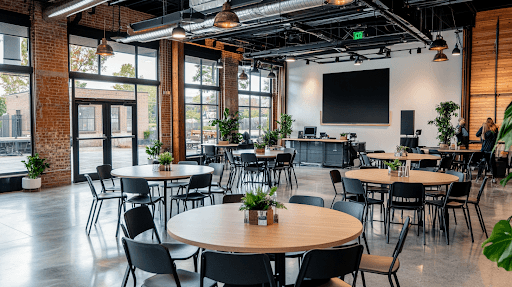B2B event marketing is a powerful way for businesses to connect, build relationships, and drive growth. But what exactly does it involve? From trade shows to virtual webinars, understanding the different types of events and their unique advantages can help businesses make smarter marketing decisions. This article covers the basics of B2B event marketing, focusing on its types and benefits.
Need a complete guide to event marketing? Our article, "Everything You Need to Know About Event Marketing," is perfect for you.
What is B2B Event Marketing?
B2B event marketing is the strategic use of organized events to engage with other businesses, build relationships, and achieve specific business objectives.
Unlike general marketing efforts, which often target a broad audience, B2B event marketing is designed to support meaningful, targeted interactions between professionals, companies, and stakeholders within a business ecosystem. It focuses on creating opportunities for connection, collaboration, and learning instead of only promoting products or services.
This approach goes beyond transactional exchanges, emphasizing the importance of fostering trust and long-term partnerships. By organizing or participating in events such as trade shows, webinars, or workshops, businesses can present their expertise, showcase their offerings, and engage with potential clients and partners in a personalized and impactful way.
To streamline your B2B event marketing efforts, download Lyyti's event marketing plan template. It provides step-by-step guidance for planning, executing, and communicating effectively across all channels. Get the template now.
Explore Types of Small-Scale B2B Events
1. Host Lunch-and-Learn Sessions
Lunch-and-learn sessions offer a practical and effective way to educate and engage your target audience in a relaxed, informal setting. Combining interactive presentations with casual dining lets you deliver valuable insights while fostering meaningful connections with attendees.
This dual-purpose approach ensures that participants gain knowledge and feel more comfortable interacting with your business representatives.
To maximize the impact of these sessions, focus on crafting presentations that are informative and relevant to your audience's specific needs. Use real-world examples and case studies to illustrate key points, making the content more relatable and actionable. Encourage questions and discussions during or after the presentation to foster engagement and address specific concerns.
Pairing the educational component with a shared meal improves the experience by creating a more personable atmosphere. Providing a catered lunch or partnering with a local restaurant can make the event more appealing and professional.
This combination of learning and networking positions lunch-and-learn sessions as a strategic tool for building relationships, demonstrating thought leadership, and leaving a lasting impression on attendees.
Plan effective communication for your lunch-and-learn sessions with Lyyti's free guide. It helps you create targeted messaging to ensure your events are engaging and valuable—download the guide now.
2. Organize Workshops and Training Events
Workshops and training events effectively promote professional development while simultaneously building valuable business connections. By offering hands-on experiences tailored to address specific industry pain points, these events can position your business as a trusted resource and an industry leader.
Attendees benefit directly from actionable solutions and practical skills that they can implement immediately in their roles. This tangible value fosters trust and creates a deeper connection with your audience.
For example, a workshop focused on mastering emerging technologies or maneuvering through regulatory changes improves participants’ competencies and demonstrates your understanding of their challenges.
Moreover, workshops' interactive nature encourages collaboration and dialogue. Participants often engage in problem-solving activities, share insights, and exchange ideas, which strengthens their relationships with your brand and with each other. This dynamic creates a rich networking environment where meaningful connections can flourish.
3. Conduct Networking Meetups
Networking meetups create invaluable opportunities for forging professional relationships in a structured, informal setting. These events are particularly effective in B2B contexts, where meaningful connections can lead to partnerships, collaborations, or direct business opportunities.
To maximize the effectiveness of a networking meetup, structure the event to support conversations while maintaining a relaxed atmosphere.
One proven approach is to incorporate icebreaker sessions at the event's start. These short, guided activities help attendees introduce themselves, share their professional goals, and identify common interests. Icebreakers encourage engagement by breaking down initial barriers and setting the tone for productive discussions throughout the meetup. Examples can include quick one-on-one introductions, thematic group activities, or even question prompts designed to spark dialogue.
When implemented effectively, such meetups foster authentic connections that are often difficult to achieve through digital channels. They allow for real-time, personal interactions that establish trust and open the door to long-term business relationships.
4. Arrange Roundtable Discussions
Roundtable discussions are an excellent way to foster collaboration and idea-sharing in B2B settings. These events create an intimate environment where industry peers can engage in meaningful conversations and tackle shared challenges.
By limiting the number of participants, you can ensure that everyone has an opportunity to contribute, creating a balanced and interactive dynamic. This setup encourages collaborative problem-solving, making generating actionable insights and building deeper professional relationships easier.
To organize an effective roundtable discussion, focus on these key aspects:
Curate a diverse group of participants: Invite professionals from varied backgrounds or roles within the industry. This diversity improves the depth of discussion by bringing in multiple perspectives.
Set a clear agenda: Define highly relevant topics to your audience and structure the conversation to keep it focused and productive.
Facilitate active participation: Appoint a skilled moderator to guide the discussion, manage time effectively, and ensure every participant's voice is heard.
Roundtable discussions offer a unique opportunity to position your brand as a thought leader. By hosting these events, you can align your organization with innovation, support valuable connections, and demonstrate your commitment to solving industry-specific challenges.
Keep your roundtable discussions on track with Lyyti's free Event Communication Timeline template. It provides step-by-step guidance on planning and executing effective event communications. Download the template now.
5. Run Virtual and Hybrid Webinars
Virtual and hybrid webinars are increasingly valuable for B2B event marketing. They offer scalable and flexible formats to engage diverse audiences. These event types combine live and recorded content, ensuring accessibility and expanding reach.
This dual approach accommodates varying attendee preferences while allowing you to repurpose recorded sessions for future marketing initiatives.
Live components, such as Q&A sessions or panel discussions, create real-time interaction and foster a sense of connection. Meanwhile, recorded elements ensure that participants who cannot attend live sessions still benefit from the content, maximizing inclusivity.
This hybrid model also enables you to engage global audiences without geographical or time-zone constraints, making it a cost-effective solution for broadening your marketing impact.
By integrating live and recorded features, webinars help you maintain audience engagement while extending the lifecycle of your event content.
"B2B events aren’t just about hosting gatherings—they’re about creating experiences that leave a mark. When you connect the right people with the right ideas, that’s when the real magic happens." - - Petri Hollmén, CEO of Lyyti
Benefits of B2B Event Marketing
1. Build Stronger Business Connections
B2B events provide a unique platform to strengthen professional relationships by fostering trust through direct, face-to-face interactions. This creates a foundation for trust, which is important for long-term partnerships.
Personalized engagement at events further improves these connections. Tailoring conversations to address specific concerns or opportunities shows your commitment and attentiveness, which can make a lasting impression.
These interactions often lead to productive follow-ups, opening doors to collaborative opportunities or even expediting deal closures. By prioritizing meaningful interactions at events, you build stronger relationships and establish your business as a reliable partner in your industry.
2. Generate Targeted Leads
B2B events are a highly effective way to generate targeted leads by attracting decision-makers and engaging them with content tailored to their interests and needs. These events create an environment where attendees can look into solutions to their business challenges, making them more likely to engage meaningfully and convert into leads.
To attract the right audience, it’s important to design events around your target decision-makers' unique preferences and priorities. For example, C-level executives might be drawn to exclusive VIP dinners or thought leadership sessions featuring industry experts, while mid-level managers might prefer hands-on workshops or product demonstrations.
Aligning the event format and content with the audience’s expectations increases the likelihood of participation and meaningful engagement.
Once attendees are present, the controlled environment of a B2B event allows you to interact with potential leads in a focused and personal way. Decision-makers value opportunities to ask questions, look into use cases, and connect directly with experts.
This dynamic fosters trust and helps establish your brand as a credible partner, leading to higher-quality leads more likely to progress through the sales funnel.
3. Boost Brand Visibility
B2B events serve as powerful platforms to amplify your brand’s visibility within your industry. You can position your business as a thought leader by carefully curating event themes that align with your expertise. This approach not only differentiates your brand but also builds trust among attendees, who often value industry insights and innovative solutions.
Crafting a well-defined event theme helps your audience associate your brand with specific expertise. For example, hosting a panel discussion on emerging trends in your sector or leading a workshop on solving industry pain points can establish your authority.
These activities demonstrate your brand’s ability to address critical challenges, making it memorable and credible in participants' minds.
Additionally, events provide organic opportunities to showcase your brand identity through visual elements like banners, presentations, and branded materials. Consistency across these touchpoints reinforces recognition, ensuring your business remains at the top of your mind long after the event concludes.
4. Present Products to Target Audiences
B2B events provide a unique opportunity to showcase your products or services directly to decision-makers and stakeholders in your industry. These events create an environment where you can go beyond explaining your offerings by demonstrating their practical applications and value.
One effective approach is presenting real-world use cases highlighting how your product solves specific business challenges. This helps attendees understand its relevance to their needs and builds a stronger connection between your solution and their pain points.
For example, live demonstrations or interactive displays can make your product’s capabilities tangible. This not only engages your audience but also leaves a lasting impression.
Additionally, offering exclusive previews can generate excitement and foster a sense of exclusivity. Whether it’s unveiling a prototype or showcasing new features before a formal launch, this strategy positions your event as a must-attend occasion.
Attendees feel they are getting privileged access, which can improve their perception of your brand and drive post-event engagement.
5. Establish Industry Credibility
Hosting or participating in B2B events is critical for establishing your industry credibility. These events provide a platform to showcase your expertise, share valuable insights, and demonstrate your business’s reliability. By actively contributing to the conversation, you position yourself as a thought leader that others in your field can trust and learn from.
One effective way to achieve this is by sharing expert insights. Whether through keynote speeches, panel discussions, or presentations, offering actionable and data-backed information helps you stand out.
Industry professionals value practical takeaways and well-researched content, which reinforces your authority.
Additionally, utilizing success stories during events strengthens your credibility. You demonstrate competence and dependability when you highlight real-world examples of how your products or services have solved challenges.
These stories create a tangible connection between your expertise and the results you deliver, making your presence impactful and memorable.
How to Start with B2B Event Marketing
1. Define clear goals
Begin by ensuring your event goals are tightly aligned with broader business strategies. For example, if your organization prioritizes lead generation, the event should be structured to attract and engage potential clients.
Similarly, activities like keynote speeches or thought leadership panels can amplify your positioning within the industry if you focus on brand awareness. By aligning these objectives, you enable consistent ROI measurement while ensuring the event directly contributes to overarching company priorities.
To make these objectives actionable, ask yourself key questions during the planning phase:
Are you targeting specific metrics, such as the number of qualified leads or attendee engagement rates?
Do your goals include tangible outcomes like product demonstrations or strategic partnerships?
How will success be measured—through KPIs like conversion rates, brand mentions, or post-event surveys?
This clarity sharpens your planning process and helps allocate resources efficiently. A well-defined goal provides a clear framework for decision-making, ensuring every event element—from format selection to content creation—serves a purpose.
To align your event goals with measurable outcomes, use Lyyti’s Reporting & Event Data feature. It provides real-time insights and analytics, helping you track KPIs like attendance, engagement, and ROI—check it out to refine your event strategy.
2. Identify a niche audience
B2B events provide a unique platform to strengthen professional relationships because they foster trust through direct, face-to-face interactions, which are more impactful than digital communication.
Targeting a specific group ensures that your event resonates with attendees and delivers measurable value for your business. A focused approach allows you to tailor the content, format, and overall experience to the unique needs of your audience.
Start by segmenting potential attendees based on their role within their organization, their industry, or their specific challenges. For example:
Job roles: Focus on decision-makers, such as C-suite executives, procurement managers, or department heads, who directly influence purchasing or strategic partnerships. Alternatively, target roles that align with your product or service, such as IT managers, if you’re showcasing tech solutions.
Industry focus: If your solution caters to a specific sector—like healthcare, manufacturing, or financial services—you can narrow your audience to professionals within that industry, ensuring the event delivers industry-relevant insights.
Pain points: Address specific challenges your audience faces, such as improving operational efficiency, reducing costs, or staying compliant with regulations. Events that address these concerns directly are far more likely to attract engaged participants.
This segmentation not only improves attendee engagement but also improves your ability to measure success.
A well-defined audience ensures your event aligns with their expectations, increasing the likelihood of generating qualified leads and building meaningful connections.
To streamline your event registrations and better target your niche audience, use Lyyti's Invitations & Registrations feature. It helps you create branded registration pages, manage participant data, and track attendance effortlessly—check it out to personalize your event journey.
3. Select suitable event formats
Choosing the right event format is important for ensuring your B2B event achieves its intended goals and resonates with your audience. The format you select should align closely with both your business objectives and the preferences of your target attendees.
If your aim is to educate and upskill participants, consider formats like workshops or training sessions. These settings provide hands-on learning opportunities and encourage deeper engagement with your content.
On the other hand, if your goal is to generate buzz around a new product or service, a product launch event might be more suitable. These events offer a platform to showcase your offerings directly to a targeted audience, creating excitement and fostering immediate feedback.
Matching the format to your goals ensures that your event delivers value, both for your business and your attendees.
4. Utilize Tools and Software
Utilizing specialized tools and software is essential to improving the efficiency and effectiveness of your B2B event marketing efforts. These tools streamline planning, execution, and post-event processes, allowing you to focus on delivering a high-impact experience for attendees.
Event management software can simplify complex tasks like registration, attendee tracking, and communication. Automating these processes reduces manual workload, minimizes errors, and ensures a seamless experience for participants.
For example, automated email systems can handle confirmations, reminders, and follow-ups, saving significant time while maintaining consistent communication.
Analytics tools are important for measuring event performance and engagement. They provide data on key metrics such as attendance rates, session participation, and lead conversions. By analyzing this information, you can assess the return on investment (ROI) and identify which aspects of the event succeeded or fell short. This insight helps you refine future strategies and focus on activities that drive the most significant results.
Resource optimization becomes more attainable when detailed insights are available. Tools that track budgets, timelines, and resource allocation allow you to prioritize impactful activities. For example, you can allocate more resources to high-performing channels or attendee engagement initiatives based on real-time feedback and historical data.
By strategically incorporating these tools into your event marketing workflow, you can simplify operations, improve decision-making, and deliver measurable outcomes that align with your business objectives.
To enhance your event marketing strategy, consider tools like Lyyti, which integrates seamlessly with platforms such as HubSpot and Salesforce. These integrations allow you to transfer event data into your CRM, providing clear insights into customer journeys and enabling targeted follow-ups. By combining event data with marketing automation, you can streamline workflows, improve engagement, and drive meaningful business outcomes.
Conclusion
B2B event marketing is both a strategic tool for engaging your target audience and a means of building long-term professional relationships. It focuses on being relevant, well-planned, and valuable to participants.
When executed effectively, B2B events drive measurable business outcomes and position your brand as a trusted presence in the industry. The success of B2B events lies in aligning them with your goals, audience, and messaging, turning moments of interaction into lasting impact.
Lyyti is a leading event management platform designed to help businesses master the basics of B2B event marketing by streamlining planning, execution, and follow-up processes. Whether for live, hybrid, or virtual events, Lyyti empowers you to deliver impactful experiences while driving measurable results. Explore how Lyyti can elevate your event strategy—book a demo today.
FAQ
What Is a B2B Event Marketing?
B2B event marketing involves hosting or participating in events to connect with other businesses, promote products, and build relationships. Examples include webinars, conferences, and networking meetings.
What Are the 4 Types of B2B Marketing?
The four types are in-person, virtual, hybrid, and experiential events, each focusing on different ways to engage audiences and expand reach.
What Is B2B Marketing With Example?
B2B marketing promotes products or services between businesses. For example, a software company sells project management tools to a marketing agency.
What Is the Rule of 7 in B2B Marketing?
The Rule of 7 states prospects need to encounter your message seven times to take action. Apply it through consistent event promotions and follow-ups.
How Do I Measure the ROI of B2B Event Marketing?
Track leads, conversions, and revenue generated from events compared to costs. Use tools like CRMs and gather attendee feedback to evaluate success.
Similar articles

Key Ideas for Event Marketing Automation to Enhance Efficiency

How to Track Event Marketing ROI with Actionable Metrics

Event Marketing Strategies: How to Plan and Measure Success

Understanding the Types of Event Marketing and Their Benefits




